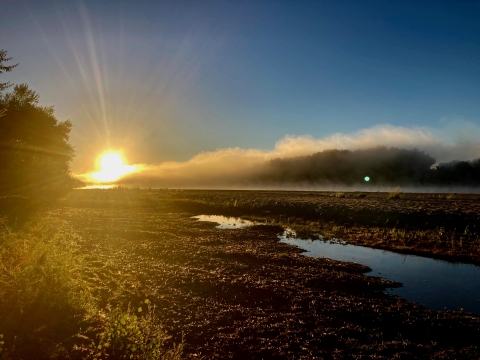What We Do
Ouray National Wildlife Refuge staff use a variety of techniques to protect and restore wildlife habitat, including prescribed fire, water level management, invasive plant removal and cooperative farming.
Management and Conservation
Management activities on the Refuge focus on protection and restoration of riparian riparian
Definition of riparian habitat or riparian areas.
Learn more about riparian , wetland, and upland ecosystems. During years with above-average river levels, the bottomlands of the Refuge flood. During dry years, additional water may be added to limited areas, but the majority of the Refuge's wetland water levels are naturally occurring. Habitat management is focused on producing a variety of habitat conditions such as mudflats for shorebirds and flood areas for feeding and nesting opportunities.
One resource management priority for the Refuge is controlling invasive plant species which compete with native species such as cottonwood trees, grasses and forbes. Naitve plants are preferred by most wildlife species for forage, cover and nesting. Control of invasive species invasive species
An invasive species is any plant or animal that has spread or been introduced into a new area where they are, or could, cause harm to the environment, economy, or human, animal, or plant health. Their unwelcome presence can destroy ecosystems and cost millions of dollars.
Learn more about invasive species and restoration of native species involves a wide range of habitat management techniques, including water management, prescribed burning, mowing, chemical treatments, and planting/reseeding of native species.
Mechanical treatments such as mowing or grinding are used to remove or reduce invasive plant species. These techniques may be combined with other treatments such as herbicide application or prescribed burning to prevent the invasive species from re-sprouting. Prescribed fire can be a very effective management tool, especially in conjunction with other methods.
Through careful planning and observation, fires are used to remove invasive species and and clear out excess fuels. These prescribed burns typically occur during the winter and spring months when moisture levels are highest to help prevent unintended damage. Chemical treatments are viewed as a last resort when other techniques will not be effective on their own. We must have an approved Pesticide Use Proposal before initiating any project involving herbicide use. Herbicides are carefully chosen and applied to minimize any unintended effects to native species. Following invasive species removal and reduction, we often plant native species such as willow or reseed with native grasses. Our goal is to increase native species that provide important food, cover, and nesting habitat for wildlife.
Selenium contamination is prevalent in this area. We have taken steps to try and prevent selenium from entering any additional Refuge wetlands, such as drying out certain high-risk areas. Selenium is an essential nutrient, but excessive amounts in wildlife and people can be dangerous. Selenium poisoning has been documented in many bird species, mammals and humans. Plants and invertebrates in contaminated aquatic systems may accumulate selenium in concentrations that are toxic to birds. Selenium poisoning may cause poor reproductive performance in birds, as well as embryonic deaths and deformities, and occasional deaths of adults.
Law Enforcement
Law enforcement officers play an important role in keeping wildlife and people safe, particularly during hunting season.




